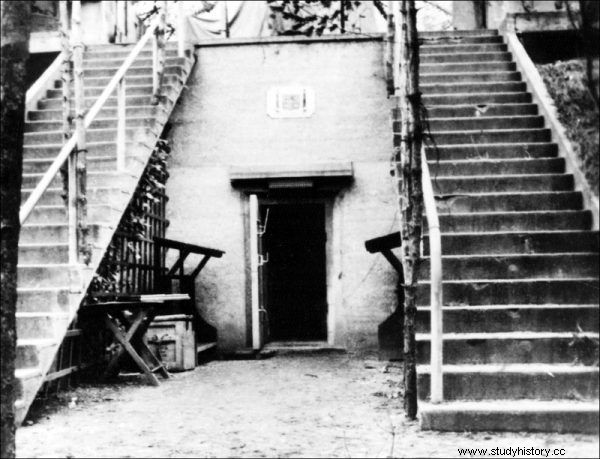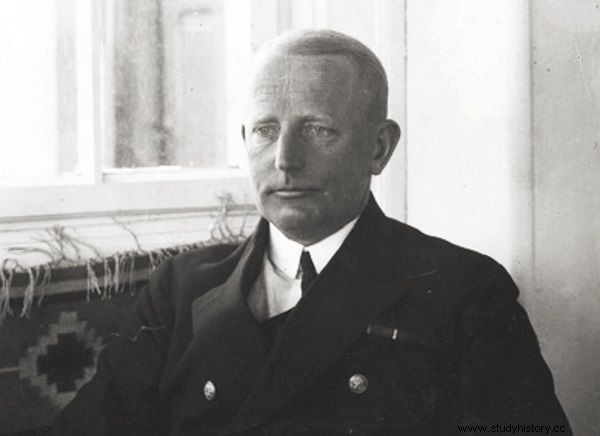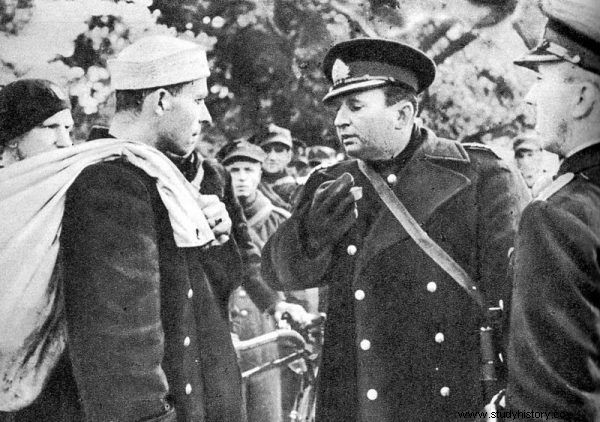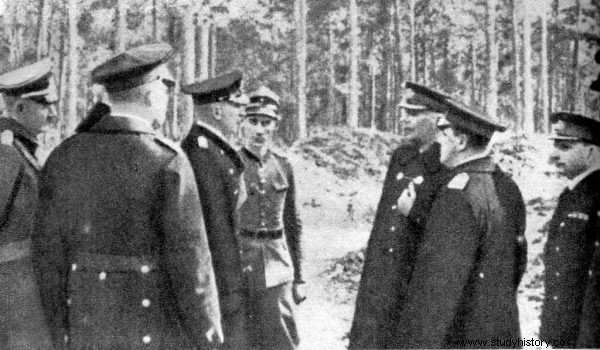Hel was under German fire from the beginning of September. Initially, the activities were not too intense. The Germans, after the experiences with Westerplatte and Oksywie, avoided the involvement of the fortress's crew in direct combat. Everything changed when the peninsula was left alone at the post.
The fall of Oksywie [September 19, 1939] opened for the crew of Hel, [where the Cadmium Fleet Command was located. Józef Unrug and the base of the Naval Defense of the Coast] a new, two-week period of its solitary defense. On September 20, there was no longer any Polish fleet, no land support for the Gulf of Gdańsk, or the "Pomorze" army in Bory Tucholskie.
In the far north there was a small piece of free land, the last rampart of the Republic on the Baltic Sea, Poland's "cow's tail" as the Kashubians used to say. The fleet command necessarily faced the question of the sense of further resistance. However, contrary to all expectations and unfulfilled hopes, it was decided to continue on a lonely post. The very idea of fighting Nazism, regardless of its immediate operational result, seemed to be a task of prime importance.
In the heat of battle
Thus, the Fortified Region of Hel, which had hitherto been on the margins of the enemy's main land and sea operations, was in the fire of direct combat. Two hundred ship artillery and ground troops of all calibers directed their barrels from several sides to the sandy hills and concrete positions of Polish guns in Hel. Condor squadrons attacked the peninsula's positions, villages and woodlands with redoubled force, spreading destruction and starting fires. The German minesweepers managed to enter the port in Władysławowo, from where they attacked the Polish defense at the base of the peninsula from the flank with impunity.
What could the commander of the Fortified Region of Hel, Comdr.Wlodzimierz Steyer, have been able to counter these preparations? There was no question of increasing the material forces of the defense from the time when the Land Defense of the Coast on the Oksywska Plate collapsed. You had to look for reinforcement on the spot, by your own means.

Cone battery them. Laskowski was the "backbone of Polish defense" in the Gulf of Gdańsk region - emphasizes Apoloniusz Zawilski.
So the lighthouse was demolished in order to deprive the Germans of a convenient aiming point, the observation point of Capt. Zbigniew Przybyszewski, commander of the promontory battery. The service of several anti-aircraft machine guns built "stork nests" in the trees to ensure the greatest possible observation of the incoming "condors". The mine dam between Chałupy and Kuźnica has been completed; it was to serve at a critical moment to cut the peninsula at its narrowest point and form an island.
Anti-landing troops were strengthened to organize at least the surveillance of the 70-kilometer-long coastline. Enterprising crews of "Gryf" and "Wicher" dismantled heavy cannons from the ships, trying to place them on concrete platforms for coastal defense from the "small sea" side. It is interesting that also the Germans - instead of attacking the Polish positions west of Nowa Wieś - hurriedly built up defensive ramparts themselves, as if fearing that the Poles might hit them. In their minds, Hel was a strong sea fortress.
Meanwhile, General Kaupisch in the Grand Hotel in Sopot devised plans to capture Hel, and General Tiedemann in Puck regrouped his forces in front of the peninsula and along the Bay of Puck. However, none of them was eager to engage in ground or amphibious operations while awaiting the results of air, land and sea bombing.
Commander Steyer turned to the Cadmium. Unrug with a proposal to fire at the quarters of both besieging generals with the help of Laskowski's battery. - I am not going to do the Polish-Kashubian war - replied Unrug, thus canceling out attempts at offensive actions on the Polish side.
First white flags?
The location of the defense was worsened by the penetration of the peninsula by enemy subversion and the inhabitants' righteous fear of the complete destruction of their homes and shabby property. So Cmdr Steyer, apart from the external front surrounding it on all sides - from land, sea and air - had, in addition, a hidden internal front. Its operation was unexpectedly revealed when the Germans - in line with the very essence of Nazism - launched terrorist raids on Kashubian villages.

An interesting fact is a fragment of Apoloniusz Zawilski's book "Battles of Polish September" (Horizon 2018 sign).
Their first target was the poor village of Kuźnica, unoccupied by the army, and therefore without air defense. More than a dozen demolition bombs smashed thirty fishermen's houses and caused heavy losses to the population. So when a similar raid on Chałupy was repeated on September 25, white flags appeared over the tallest houses and on the church tower . There were also single people waving white sheets. The incident was resolved, but there was no time to clarify the matter. It is only known that the leader of this defeatist action escaped by boat to the shores of the Bay of Puck.
After a six-day bombardment on the peninsula, the German command became convinced that the will of the defenders had been sufficiently disturbed, directed a new expedition of combat ships to Hel. This time both "Schlesien" and "Schleswig-Holstein" battleships under the command of adm. Schmundt, with a total of 18 288 and 150 mm guns.
The expedition of the battleships was preceded by a minesweeper flotilla, which was to clear the road for the largest German ships in the Baltic Sea from mines and cover them with a smokescreen for as long as possible. The "Schlesien", having reached the level of Redłowo, first opens fire on the objects of the Hel headland. Laskowski's battery under the command of Capt. Przybyszewski responds as usual with fast, effective fire .
Already the third series covers the target. One of the minesweepers puts a new smoke screen in front of the battleship. At that time, Capt. Przybyszewski moves fire to "Schleswig-Holstein". As a result, both battleships give up other targets and center all fire on Laskowski's battery. However, the fearless crew - despite the damage of two guns, the failure of the rangefinder and the casualties - continues the fight. Finally, after an hour's exchange of shots, the two battleships decide to reverse.
This success of the Poles had an excellent impact on the defense, especially since the damage to the equipment turned out to be superficial, it was possible to quickly remove it and restore the battery to full combat efficiency. The hero of the day was the battery commander, who, despite his wound, did not leave the vantage point and directed the fire until the enemy ships were driven away.

"I do not want to start a Polish-Kashubian war," said Rear Admiral Unrug, rejecting the plan to undertake offensive actions.
"Everyone will capitulate in September ..."
After a 48-hour break, a new strike of German battleships sets off on September 27. This time they used a different tactic. "Schlesien" headed towards Kępa Oksywska and, at the height of Mechelinki, set up for the fire, the aim of which was to be the Polish fortifications between Hel and Jurata. On the other hand, the "Schleswig-Holstein", having left Nowy Port at 8.30 am, took a course to the high seas, then at the height of the Hel headland, made a sharp turn and from a distance of 13 kilometers directed all its fire on the Laskowski battery and the position of the anti-aircraft squadron, which the German had spent from the horizon observation plane. This mighty cannonade of two battleships started at 12 o'clock and lasted over an hour.
And this time the fire of the ships' guns did not cause too much material damage to the defense system. However, its enormous intensity shook the morale of the soldiers who were idle at that time . 40 288 mm rounds were fired on Jurata alone. Laskowski's battery, fighting effectively with the battleship "Schleswig-Holstein" that day, also did not suffer losses, but suffered more and more from the lack of ammunition.
The night of September 27-28 greeted the Fleet Command with the feeling of being able to repel a strong enemy attack. The crew of the headland battery enjoyed the victory over the overwhelming enemy. But alas, it was not a night that would give you a well-deserved moment of rest. The Fleet Command received a radiograph from Warsaw about the capital's decision to surrender. Rear Admiral Unrug received from General Rómml, as the oldest commander fighting in the country, a free hand to continue the fight.
- Everyone surrenders in September - said Cmdr Steyer present at the briefing - we will hold on until October .
While awaiting the start of the decisive German attack from the land, all infantry units, regardless of their origin, were subordinated to the commander of the KOP battalion, Maj. Jan Wiśniewski. However, it did not have any practical significance, because the Germans started offensive actions the next day. In fact, the width of the peninsula did not allow more forces to fit. Thus, a battalion of the 374th Regiment, thrown into the depths by companies, started its attack. On the other hand, the German artillery shelled Polish positions along their entire width and depth.

"We will endure until October," said Commander Włodzimierz Steyer.
The Polish guns are silent, because there is only as much ammunition left as it will require to repel the general assault . During the day of September 29, the 9th German company approached the positions of the 10th company of the KOP, Lieutenant K. Gilunia, west of Chałupy, getting ready to attack the next day. In this situation, everyone is shocked by the news about the attempt to sail towards Puck by the 13th landing company of Lieutenant Emil Okińczyc from the headland of the peninsula. It was the result of the "psychological war" continued by the enemy, especially since the capitulation of the capital.
Recent clashes
The Fleet Command, however, did not give up. On September 30, from the morning, German artillery fire on Polish positions from Chałupy to Jastarnia. But the infantry attack comes out only at noon, after a short fire of several light and heavy batteries, to the 1st position, which becomes disorganized. The KOP company, losing many prisoners, retreats to the 2nd position, and shortly afterwards to the 3rd position - to the Kuźnica region, with 80 torpedo warheads being launched into the air. Although the spit has not been broken, the momentum of the German strike is dying out. Kuźnica remains in Polish hands.
Fleet Command wishes to reject the enemy. To this end, he directs the 12th reserve company to the counterattack. Unfortunately, in Bór, almost half of the company sits under white flags. The situation was resolved, but the number of casts decreased significantly. Under these conditions, the Fleet Commander announced his decision to surrender. Although the KOP battalion and the naval personnel troops were ready to resist without restriction, this attitude was dominated by ordinary human logic.
Reservists from the surrounding villages, lost three weeks ago, watched with despair in their hearts at the fire of their homes, although they faithfully fulfilled their duty to defend the country, as long as it made sense. However, when Warsaw fell and aid from the West did not come, they could not understand the purpose of the further fight. The soldier agreed to fight in defense of real values, the fight only for honor was incomprehensible to him.

Hel capitulated on October 2, 1939.
Fighting in the Kuźnica area with the 3rd battalion of the 374th Infantry Regiment continued for two days. The Germans put into action on both sides of the peninsula light units of their fleet, which were to fire at Polish positions with flank fire and wing them with human forces. However, it did not come to that.
On October 1 at 2 p.m. there was a ceasefire. Five minutes before the end of the fight, the thirty-second plane was shot down over Hel . After the ceasefire, a team of minesweepers followed a rough trail along the coast of the peninsula, losing the M-85 catcher on one of the mines laid in early September by the submarine "Żbik". On October 2, the commanders said goodbye to their troops and, after singing the national anthem, separated from them. In total, about 3,200 people were taken prisoner on Hel. Losses in the wounded and killed amounted to approximately 200 people.
Source:
The above text was originally published as part of the monumental work of Apoloniusz Zawilski Battles of Polish September (Horizon 2018 sign). The title, lead, illustrations with captions, bolds and subtitles come from the editorial office. The text has undergone some basic editing to introduce more frequent breakdown of paragraphs. For the sake of uniformity of the text, footnotes in the book version have been removed.
